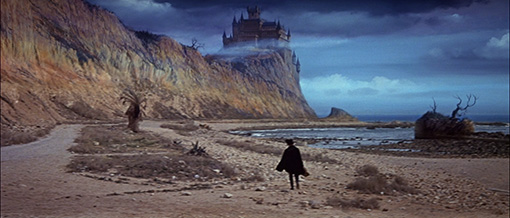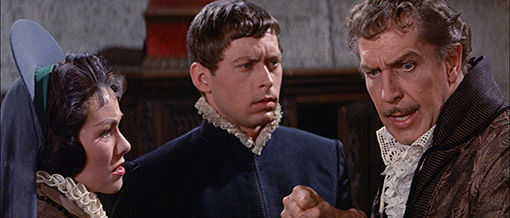|
When you're young, you don't tend to waste much time pondering on how you might die. That's probably best, as this is where childhood traumas are born. Get a bit older and you become aware that you're not as invincible as you once believed, and a few years later and you're ready to start placing bets on what your cause of death will be. But as a kid, death is largely an abstract concept, in part because most of us aren't really exposed to it and its consequences at that age. Speaking personally, I became more aware of what it actually means to die by watching movies. People around me weren't dying, but people I'd developed a relationship with over the course of ninety minutes certainly were. The first death that really upset me was in a movie. I can't remember which one, but I do remember being grilled by my father on why I was crying and making something up. How could I tell him that a movie had so upset me? What an absurd notion. Little did I know...
It's also through this relationship with the silver screen and its living room equivalent that I was first able to contemplate the idea that death might not be as simple as wheezing out a heartfelt sentiment and falling asleep, usually in the arms of the very loved one that you wanted to deliver that final message to. You can thank horror movies for that. People rarely die peacefully and easily in horror. But I was still young enough then to convince myself that I could somehow cheat the deaths that had floored these film characters. Thus if pushed off a cliff I was sure I'd be able to grab a protruding branch on the way down or land in deep water and swim safely to the shore. If shot in the chest then the bullet would pass through without hitting any major organs (I'd suck in my lungs at the very last moment if need be). If hit by a car then... hell, I was hit by a car as a kid, hard enough to knock me out and spin me through the air, but I survived with only a few serious grazes to my legs and head. No, you can't kill this kid. Then I saw a film that proposed a death that my young mind couldn't envision an easy way out of, and I realised, above all else, that one way I absolutely didn't want to die was to be strapped to a table and slowly cut in half by a giant swinging pendulum.

I was in my mid to late teens before my relationship with the films of Roger Corman began in earnest. By then I'd seen two or three of his films, but hadn't yet connected the directorial dots. Film school changed all that. You saw a film you liked and the first thing you did was look up what else he or she might have done. A mere mouse click or two now, it was once a task and a half, one that required the assistance of film libraries and specialist magazines to complete.
By the time I attended the National Film Theatre's season of Roger Corman films, I was becoming all too aware of his sizeable body of work and his influence on a whole new generation of American filmmakers. You want a list? Check out the opening paragraph of my review of the documentary, Corman's World: Exploits of a Hollywood Rebel. A master of low budget exploitation, one that earned him the moniker 'King of the Bs', Corman actually was and is a confirmed cineaste, one whose favourite filmmakers include Antonioni, Fellini, Buñuel, Bergman, Kubrick and De Sica. Yet he never got to make his Bicycle Thieves, his Rashomon or his The Seventh Seal. What he did instead was create a series of eight thoughtful film adaptations of Edgar Allen Poe stories during the fruitful period between 1959 and 1964. All but one starred Vincent Price, and they remain to this day his most regularly and enthusiastically acclaimed works.
It was the second of the series, Pit and the Pendulum (and despite how it is written on posters and even the cover artwork of this disc, the title on the film itself lacks the definite article present in Poe's original) that I saw first, on TV and with the scope picture horribly cropped to 4:3. But it made an impression. Well, one scene certainly did. Years later I struggled to recall the plot or the characters in meaningful detail, but could remember almost every shot of that swinging pendulum, and would shudder at the very thought of the moment it slices through its victim's shirt, and by association the flesh holding his intestines in place. Yikes.

Superb though Poe's original story is, it doesn't provide much meat for feature film adaptation, consisting as it does of a single claustrophobic sequence of Inquisition torture, told from the viewpoint of the victim. Screenwriter Richard Matheson expands on this by creating a two-act build-up to this climactic scene that borrows themes and character details from other Poe stories. So what's it all about?
In 16th century Spain, a young man named Francis Barnard arrives at the door of a remote cliff-top castle owned by Nicholas Medina to investigate the untimely death of his sister Elizabeth, to whom Nicholas was married. Neither Nicholas nor his younger sister Catherine are able to offer a comprehensive explanation for Elizabeth's passing, but Dr. Leon, the family physician, claims that she was the victim of a massive heart failure and even suggests that she died of fright. Whatever the cause, Nicholas appears to have been deeply affected by her death and is haunted by the notion that she may have been prematurely interred. But during the course of Francis's visit, there are increasing signs that while his sister's body may have been laid to rest, her spirit may be still active within the castle walls.
Corman plays a rather neat trick on us here. By starting the film in almost the exact same manner as his previous Poe adaptation, The Fall of the House of Usher (also scripted by Matheson), he subtly misleads us into thinking that the characters here will serve the same function in the narrative. It's a ploy aided by the casting of Vincent Price as Nicholas, who by then was making his name as a horror icon and at first appears to be rerunning his role as the tortured Roderick Usher in the previous film, complete with the same fears regarding premature entombment of a loved one. Thus when the strange occurrences begin, we tend to suspect that Francis may be correct when he accuses Nicholas of manufacturing the evidence of Elizabeth's still-active spirit. But there's something oddly real about Nicholas's grief and despair, subtly captured by Price in a too-often underrated performance, that gradually sells the notion that there really is something unearthly going on here. Certainly Nicholas is a lot more sympathetic a character than Francis, played as gruffly unlikeable by John Kerr in a performance that was wonderfully described by filmmaker Joe Dante as one delivered by a man who had been mugged on the way to the studio.

Structurally, the film may seem a little slow to get going, opening as a situation and character-setting costume drama punctuated by stylised flashbacks to Nicholas's marriage to Elizabeth and a traumatic incident of his youth, one that could just be feeding his current paranoia. But following the first of the strange supposed hauntings – a harpsichord played at night in a manner that convinces Nicholas that it was Elizabeth – the film rarely pauses for breath. It's clearly all building to something, and on this score Matheson and Corman really deliver the goods in two separate, satisfying and game-changing twists, the second of which paves the way for the third act reversion to Poe's original story. And what an act it is. For those unaware souls, the pendulum in question is a torture device employed by the Spanish Inquisition to terrorise its victims.* A gargantuan instrument of over 30 feet in height, it consists of a giant geared wooden arm fitted with a large curved blade. As the arm swings, it gradually descends, edging slowly towards the stomach of the splayed and shacked victim on the table below. And boy is it vividly realised here, a striking combination of convincingly solid sets and mechanics, Daniel Haller's sumptuous production design, Floyd Crosby's beautiful scope cinematography, the precision timing of Anthony Carras's editing, and some superb matte painting work from the uncredited Albert Whitlock. It's the scale in particular that sells this as real, the swoop of the pendulum arm and the heavy metallic blade as convincing a physical threat as you'll find anywhere in the horror cinema of the period.
Coming back to the film after so long a break, particularly looking as ravishing as it does here, it seemed even better than my fond memories of it had led me to expect, and second and third viewings only enhanced its qualities further. If there's a weakness, at least from a modern perspective, it's in the casting of an actress as iconic as Barbara Steele in a role that the plot is trying to keep under wraps, one her placement on the front-end cast list assures you is going to be larger than the brief glimpse of her you get in the flashbacks. But she's still divine casting, the timing of her appearance and narrative purpose judged to perfection and her expressive features really bringing home the emotion behind her attentions. And Steele had the best female eyes in the business, and it's her ability to express so much through them that make the film's final shot such a haunting humdinger.
The HD master for this transfer was created from a 35mm scope interpositive and a 35mm restored mono magnetic element, with the work performed at Ascent Media in Burbank, California. The master was delivered by Hollywood Classics. Additional picture restoration work was carried out using a combination of software tools and techniques at Deluxe Digital under the supervision of James White. If you already have Arrow's splendid Blu-ray of The Fall of the House of Usher you'll be primed for what to expect here, a handsome, richly detailed 2.35:1 transfer with a generous contrast range and terrific colour, something that leaps from the screen in the film's psychedelic opening images. There is occasionally some very slight picture movement and a few very brief instances of dirt remain, but otherwise this is a sparkling restoration that beautifully showcases the films richly realised cinematography, production design and matte work.

The original mono 1.0 soundtrack is the only one available here. Inevitably there is some restriction in the dynamic range, and background hiss is evident on quieter scenes, but the dialogue is clearly handled and there is no distortion even on the louder elements of the score.
Also included is an isolated music and effects track, which is slightly clearer than the main track and with less background hiss.
English SDH subtitles are also on offer.
Commentary with Roger Corman
For my money, Roger Corman has one of the loveliest voices in the known universe. I could listen to him all day speaking about anything, and he really is one of the most interesting talkers you're ever likely to encounter. Thus listening to a Roger Corman commentary is like being warmly embraced by the silkiest collection of facts and anecdotes you can imagine. The commentary here is no exception, with the director providing information on all aspects of the film's production, including: the selection of actors; working with composer Les Baxter; the paintings that adorn the walls; his more confident use of CinemaScope following his first use of the format in House of Usher; the matte paintings; the distorted imagery and colour tinting; and a whole load more. His admiration for Vincent Price as an actor is clear, and he provides a frank and detailed breakdown of the film's Freudian undertones – it would probably not otherwise have occurred to me that the castle was designed to be read as a woman's body and its front door and corridors as a vagina. You live and learn.
Tim Lucas commentary
And once again I have to swallow my former dislike of so-called 'expert' commentaries, those delivered by writers or critics who were not involved in the original production. Novelist and Video Watchdog editor Tim Lucas delivers a consistently compelling reading of the film and its themes, providing brief biographies of the actors and a complex and persuasive analysis of the film's narrative and subtext. He also discusses the scope compositions, the music score, Matheson's original script (which is quoted from), the negative contemporary reviews of Price's performance, the film's similarities to Henri-Georges Clouzot's Les Diaboliques, and the influence of Poe's original story, to name but a few. And how appropriate that this commentary was recorded on the 250th anniversary of Edgar Allen Poe's birth.

The Story of the Swinging Blade (43:07)
A newly made documentary, the work of Arrow regular Callum Waddell, that looks back at the making of the film through interviews with producer-director Roger Corman, actress Barbara Steele, Re-Animator producer and Society director Brian Yuzna, journalist and film historian David Del Valle, and Vincent Price's daughter Victoria. An always welcome addition to any Arrow release, this typically informative documentary is littered with interesting recollections and comments: Corman reveals that he wanted to make Masque of the Red Death after The Fall of the House of Usher but was concerned about comparisons to Ingmar Bergman's recently released The Seventh Seal, and assures us that Richard Matheson scripts were usually good to go on the first draft; Barbara Steele tells us that she loved Vincent Price and claims that her voice was not dubbed in the film (the official version is that it was); Brian Yuzna recalls his first viewing of the film and opines that Barbara Steele was great in anything she appeared in (get's my vote); David Del Valle states that "All of us who grew up with Vincent Price owe him a debt"; and Victoria Price nicely describes her father's later screen image as "the elegant side of evil." There's loads more here. Splendid.
An Evening of Edgar Allen Poe (53:07)
A bit of a treat this. In what is effectively a filmed one-man show, shot for television by AIP and broadcast in 1970, Vincent Price performs four of Poe's short stories before a live audience: The Tell-Tale Heart, The Sphinx, The Cask of Amontillado and, of course, The Pit and the Pendulum. Price is in full flow here, notably in expressing the anguish and torment of the characters from whose viewpoint each of the stories are told. Just occasionally you want him to reign it in a tad, but this is still a valuable, hugely enjoyable and most appropriate inclusion. Handily, this feature has chapter stops at the start of each story.
Added Television Sequence (5:04)
An extra sequence shot by Corman's assistant Tamara Asseyev that was added for the film's television screening in 1968 to enable it to fill a 2-hour time slot, which gives you an idea just how many commercial breaks there must have been (so why not just add another?). The sequence in question has Catherine Medina imprisoned in an asylum, and watching it in isolation it's hard to imagine exactly how it fitted into the film.
Original Theatrical Trailer (2:30)
An intriguing trailer that has a few dust spots but is otherwise in decent shape and in the correct scope ratio. Structurally it's a little wobbly and has a couple of serious spoilers, but the voice-over is great fun, assuring us in all sincerity that the film has "all the violence of angry seas." Come again?
Booklet
The centrepiece of this typically fine full colour booklet is a fascinating essay on the film and its release by American Gothic: Sixty Years of Horror Cinema author Jonathan Rigby, which includes an examination of Price's performance and the critical response to it and some choice technical information on the pendulum sequence. There are also plenty of stills and the main film credits, and I really liked the fact that the page numbers are framed in a small pendulum blade. But that's just me.
A fabulous and richly cinematic reworking of one of Poe's most influential stories is given luxurious treatment by Arrow, with a lovely transfer backed up by a chest full of excellent extras. As with The Fall of the House of Usher, you can also buy it as a Steelbook Edition, and I can't be the only one wondering if any more of Corman's Poe adaptations are set to receive the same fine treatment in the future. Highly recommended.
* There has been some debate over whether the device was actually used by the Inquisition or whether history has become muddied by Poe's story. Personally I wouldn't put anything past those bastards.
|